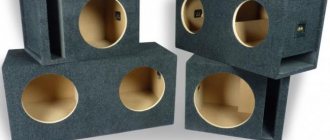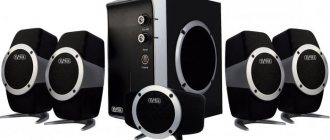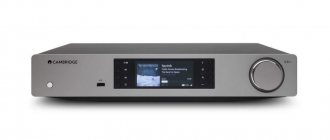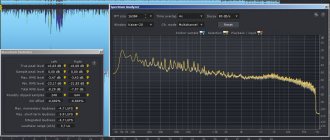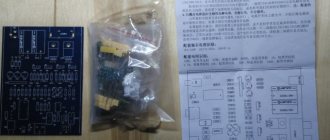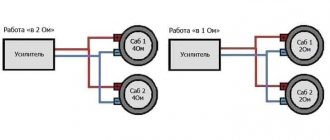We continue our research into the most popular sector of acoustic systems, which can be conditionally limited to a price level of 150 thousand rubles. Last time we listened to quite serious bookshelf speakers from Quad, Wharfedale and Tannoy. And today, having slightly increased the budget, let’s look at floor-standing models in this price segment.
Save and read later -
Choose
The selected price level can conditionally be considered a starting point for floor-standing speakers, which can claim a place in the box with the enticing name “upper Hi-Fi”. Here it is quite possible for the manufacturer to achieve decent sound without regard to the price tag, and tangible freedom from constructive compromises typical of budget acoustics. Today, for a comparative test of floor-standing speakers, we selected a rather interesting group of participants with various technical “chips” in their design. For example, coaxial drivers and ribbon tweeters were previously used mainly in top-end acoustic models, but now, thanks to proven technology and lower production costs, such heads have become more accessible and are used in models in the mid-price range. Two of the contenders - Wharfedale Reva-3 and Tannoy Revolution XT 6F - are made in a 2.5-band concept, and the third participant - DALI Opticon 6 - is equipped with a proprietary combined high-frequency module, due to which the 2.5 + 0.5 band concept is implemented.
B&W 804D3
Bowers and Wilkins (B&W) is one of the few manufacturers that can prove its ability to develop equipment for connoisseurs of impeccable realistic sound. The secret of success is the active development and implementation of the best existing acoustic technologies. B&W 804D3 is a Hi-End product.
Proprietary technologies as the secret to the model’s success
With each subsequent model, B&W manages to achieve benchmark quality. This is achieved thanks to the following factors:
- Diamond tweeters for rich tones and perfect sound purity.
- Low-frequency Aerofoil diffusers that provide volume and depth of sound, impressive bass.
- Matrix system with internal ribs of increased rigidity, providing additional reliability of the frame.
Advantages and disadvantages of the model
In addition to the advantages listed above, owners of the B&W 804D3 will be pleased with:
- Impeccable sound purity in any frequency range.
- Increased design reliability.
- Rigid, inert housing that eliminates vibration.
- Composite structure of the diffuser, providing greater openness of sound.
But at the same time you will have to come to terms with the impressive weight and the cost corresponding to all the listed advantages.
We study
The history of the emergence of the Reva series of acoustic systems from the British company Wharfedale is very unusual. In most cases, the budget line of acoustics is the result of various simplifications and compromises of models from higher price segments. In this case, the British from Wharfedale did exactly the opposite - they chose the popular Diamond 200 series as a basis, which underwent deep tuning, not only in terms of sound quality, but also in terms of design and sophistication of the cabinet finish. For obvious reasons, the price has also increased.
Every time you come across Wharfedale products, you are amazed at the quality of the cases. The mahogany veneer is covered with seven layers of piano varnish, which creates an irresistible desire to immediately touch the speaker. In order not to disturb the monolithic beauty of the front panel, protective grills use magnetic fasteners mounted inside the facade. Like the familiar Wharfedale Reva-2 shelf model, the body here tapers in depth. In addition to the originality of the design, such a cabinet profile reduces the likelihood of standing waves and resonances. The acoustic inertness of the body is also facilitated by the multi-layered material from which the walls are made, which is a combination of fiberboard and particleboard, as well as the abundance of internal ties.
All drivers used in the Wharfedale Reva-3 design are in-house developed. The textile of the inch tweeter is treated with a special damping compound, giving the soft dome a noble metallic shade. The diffuser of the mid-frequency driver with a diameter of 11.5 cm is made of fiberglass and mounted on a rubber suspension, which provides it with a fairly large stroke. The two bass drivers are structurally similar, but have diffusers with a diameter of 12.5 cm. Linkivitz-Riley crossovers divide the operating range at frequencies of 450 Hz and 2.6 kHz, with the midrange working from the very bottom, that is, the Wharfedale Reva-3 implements 2. 5-way circuit. The vertical patch panel at the bottom of the rear wall of the case is equipped with high-quality screw terminals and allows bi-wiring and bi-amping connections of speakers to amplifiers.
Like the younger shelf model Reva-2, the dual port here is located on the bottom wall of the case, and for its normal functioning, the speakers are installed on platforms with a small gap between them and the speaker cabinets. This solution not only improves the sound of the bass, but also allows for greater freedom in positioning the speakers in the room - the Wharfedale Reva-3 can be moved quite close to the wall without fear of degradation of the bass register. It is interesting that, as in the previous test of bookshelf acoustics, today another participant’s design uses a similar scheme - these are the snow-white lacquer Tannoy Revolution XT 6F.
The XT in the latest generation of Tannoy's popular Revolution series of loudspeakers stands for eXtra Technology, emphasizing the use of the company's latest technologies in their design. The main feature of almost all models of the legendary Scottish company, except, perhaps, the most budget lines, was the proprietary coaxial emitter. The Tannoy Revolution XT 6F, like the bookshelf Tannoy Revolution XT 6, which we talked about recently, uses the latest version of the Omnimagnet Dual Concentric coaxial driver, which differs from previous implementations by a single magnetic system for both speakers - the tweeter and the mid-range driver. This solution contributes to even better coordination of their work in time and phase. Another difference of the new version is the toroidal tweeter diffuser, thanks to which it was possible to make the waveguide shorter, which, in turn, expands the radiation pattern and makes it easier to combine the acoustic centers of the emitters. Such a combination contributes to the correct construction of the scene in a larger sector, even when the listener deviates from the axis of the coaxial speaker.
In floor-standing models, the Omnimagnet Dual Concentric coaxial driver is complemented by a bass driver of the same diameter (for the Revolution XT 6F - 6 inches, for the older Revolution XT 8F model, respectively, 8 inches), which provides clear support from below even for such a relatively small volume of the speaker. At first glance, the diffusers appear to be aluminum, but they are not. They are made of a special cellulose-fiber material with very low weight and are driven by small (44 mm) and therefore light voice coils.
Internal resonances and standing waves are successfully counteracted by the trapezoidal shape of the cabinets, carefully finished in luxurious white piano lacquer. Nothing disturbs the solidity of the front panel on which the speakers are mounted - the magnets for fixing the protective grills are hidden inside the facade. The grills themselves are made of black, acoustically transparent material on a plastic frame. One of the main features of the Revolution XT series in general and the 6F model in particular was the bass reflex port mounted in the bottom of the cabinet. To ensure the operation of the port, the speaker housings are installed on platforms with a small gap. The tweeter of the Omnimagnet Dual Concentric coaxial driver is optimized to work with first-order shallow filters, characterized by the shortest signal path, which contributes to the airiness and transparency of the sound. Like the younger shelf model, the crossover frequency of the coaxial driver heads is chosen quite low - at around 1.8 kHz. And below 250 Hz, the bass driver is additionally activated.
The design of the crossovers uses audiophile components, and the internal wiring is made of silver-plated oxygen-free copper cable. The patch panel at the bottom of the rear wall of the case is equipped with two pairs of gold-plated screw acoustic terminals, that is, it allows two-cable connection to the amplifier.
Crowned with the EISA title of "Best Home Cinema Speakers 2016 - 2017", the DALI Opticon 6 ranks second from the top of the Opticon series - above only the 3.5-way DALI Opticon 8 with a pair of 8-inch bass drivers. When examining the design of the DALI Opticon 6, many things may surprise you. Unlike other participants in today's competition, these speakers are made according to the 2.5 + 0.5 strip design. Let's try to figure out what this means. The operation of a pair of 6.5-inch woofers here is organized in a manner familiar to 2.5-way acoustics - the area of responsibility of one of them extends right up to the boundary beyond which the dome tweeter (2.2 kHz) is activated, and the second driver operates only below 800 Hz. But the DALI Opticon 6 uses a hybrid tweeter - more precisely, two different types of tweeters. The soft silk dome tweeter operates from 2.2 kHz to approximately 20 kHz (its operating range is not artificially limited at the top). The second high-frequency tape-type emitter switches on at 14 kHz and provides signal reproduction up to 32 kHz. The manufacturer called this scheme +0.5 stripes. This rather complex configuration has a single goal - better coordination of the operation of the emitters in the acoustic system, especially at the junctions of the strips. The usual problems in these parts of the spectrum in DALI Opticon 6 are partly compensated for by overlapping the areas of responsibility of the speakers. In addition, the use of a hybrid HF module makes it possible to expand the resulting radiation pattern in the high-frequency region (the most sensitive to the direction of radiation) due to the fact that the radiation dispersions of ribbon and dome tweeters are significantly different.
A pair of drivers responsible for the low/mid range are also DALI’s own design. Diffusers of a signature brown-copper color are made of cellulose interspersed with wood fibers and successfully combine high rigidity and low weight. The diffuser hangers are made of soft rubber.
The design feature of DALI Opticon 6 is the contrast of the front panel with the rest of the speaker body. The facade is covered with black piano varnish, while the remaining surfaces are matte - covered with vinyl film under black maple or light walnut veneer. A completely snow-white version is also offered, but the contrast of the polished front panel and matte sides is preserved. Like the rest of the test participants, the DALI Opticon 6 is equipped with two pairs of gold-plated screw-type acoustic terminals. It is gratifying to note that the speakers are not only made in Denmark, but are also marked with the personal signature of the master. A touch that is worth a lot these days.
How to choose the right speaker system
- Type . Acoustics are divided into passive, active and hybrid. The first does not require a line signal and power supply to all speakers, but requires an external amplifier. The second is portable, compact, and easy to set up. Hybrid systems include passive speakers and an active subwoofer.
- Number of stripes . The optimal option is two: one is responsible for the lows (and the bottom of the midrange), and the second is responsible for the highs (and the top of the midrange). Of course, a 3-way speaker system provides better sound quality, since different drivers are responsible for the lows, mids and highs. But the average user is unlikely to be able to notice serious differences, but he will have to overpay for such speakers.
- Power . The sound quality depends on this parameter. Based on the area of the premises, a speaker with a power of up to 70 W is sufficient for rooms up to 20 m2. If you need to cover 30 “squares”, then 100 W will be the best option. Rooms over 30 square meters will require 150 W or more.
- Sensitivity. Determines the sound volume taking into account the specified power. As a rule, indicated in dB/W/m: the sound pressure of a radiator with a power of 1 W at a distance of a meter. Sensitivity up to 88 dB is considered low; with a value from 89 to 92 – average; in the range of 94-102 dB – high.
- Frequencies . Conventionally, frequencies perceived by the human ear can be divided into three categories: high, medium and low. If acoustics are purchased for cinema, then they must cover the range from 100 Hz to 20 kHz. For universal models it should be wider (about 20-35000 Hz).
- Interfaces . RCA is necessary for single-channel audio transmission, but the connector's noise immunity is low. XLR, on the contrary, is highly immune to interference. It is considered a professional interface. The acoustics can also be equipped with TRS (3.5 and 6.35 mm), Speakon (needed in concert equipment), etc.
Connecting
Once again, testing was carried out in the hospitable AV Comfort South salon on Prazhskaya. The test system has undergone changes - if the source remained the same - a network audio player Musical Fidelity M1 CLiC, then the integrated amplifier is now a hybrid Magnat MA 1000, combining the warmth of tubes in the preliminary amplification stages with the power of output stages on discrete complementary pairs of transistors manufactured by Toshiba.
The speaker systems were installed far enough from the walls so as to form an equilateral triangle with the listeners. We turned the Wharfedale Reva-3 and Tannoy Revolution XT 6F speakers slightly towards the listeners, and DALI Opticon 6 were placed parallel to each other in accordance with the manufacturer's recommendations, due to the peculiarities of the polar pattern of the hybrid high-frequency module. Despite the fact that all test participants are equipped with two pairs of acoustic terminals and allow dual-cable connections, this feature was not used during the test. And we remember the need to preheat the acoustics - on average, about 100 hours of operation are required for the speakers to reach basic sound characteristics.
Handwriting
The floor-standing system with index 6 turned out to have a different sound signature, which takes longer to get used to. Here the developers seemed to come to their senses and decided to force the upper hand after all. It even worked with a “light”. Therefore, be prepared that the tape hiss is emphasized quite persistently on older recordings. On the other hand, for soundtracks, some harsh sound at the fronts seems justified. As part of a home theater, these speakers are definitely not a problem.
If we compare the style of the Spektor 6 model with the Spektor 2 bookshelf speakers, the mids here are not so pronounced (again, vocals should probably be expected from the center channel of the same name). The sound turned out to be colder and denser than that of the “twos”. The inconsistent nature of the bass can give the sound a "basement" quality. Is it good or bad? You can also refer to the need for warming up, since I didn’t live with these speakers for a month, but just spent the weekend. In the end, the same Katch after a long break, the first half hour generally sounds quite harsh. Ok, I'll try to add some more comparisons and observations.
There are only two color options, but the walnut finish looks very decent and will suit many
My floorstanding "Frankensteins" of comparable displacement (former Zingali with a converted crossover and a Morel dome midrange) are inferior to the degree of cold fury that the Spektor 6 is capable of. Let's just say that the Dali guitar sounds more impressive than the drum kit. In Dali, the bass has fewer shades, but the presentation is brighter, “garage-like”, it also looks more frank, which will undoubtedly add charm and expressiveness to a whole bunch of rock soundtracks.
Classic speaker connection diagram
My home speakers have more “ambience”, the bass is clearer, the high-frequency sound is softer, and the after-sound is longer. But after a session of Spektor 6, at first it seems that my speakers are playing from behind a curtain. Dali plays quite realistically on powerful guitar compositions, but you can hardly count on these speakers as a background. We lower the volume, both the bass and the fundamentality disappear, although the clarity of the highs remains.
Let's listen
You will recognize the signature style of Wharfedale acoustics immediately after you start listening to the Wharfedale Reva-3. The characteristic timbral fidelity and accuracy of transmission of the high-frequency spectrum allow the speakers to reproduce acoustic instruments very naturally; the interpretation of acoustic strings is especially well perceived. The slight detachment of HF delivery, noted when listening to the Wharfedale Reva-2 bookshelf ones, is preserved here. The speakers convey large-scale musical canvases quite confidently - the Wharfedale Reva-3 has no problems with either dynamics or the formation of large shapes. For obvious reasons, the bass depth here is better than that of the younger model, however, this model still cannot be called bassy. Once again, we note the excellent consistency of the work of the emitters - it is absolutely impossible to detect by ear the boundaries between the areas of responsibility of the speakers.
The delivery character of Scottish acoustics is also instantly recognizable. The Tannoy Revolution XT 6F is fully endowed with all the family features. Comfort and softness of presentation, a very intelligent, and at the same time emotional interpretation of jazz, blues and chamber groups is combined here with the ability to build a large-scale stage with very precise positioning of virtual sound sources. The bass is dynamic and fast, and the speakers do not give up even at the very bottom of the operating range - no hum or muttering was detected. A neutral tonal balance has the most beneficial effect on the reproduction of acoustic instruments, but in rhythmic rock compositions some may lack “meat”.
The contribution of the ribbon driver is immediately noticeable in the sound of the DALI Opticon 6. Filled with the smallest details, an airy and sparkling sound canvas can only be formed by “electrostats” and “tape”. Despite the presence of actually two tweeters, there is no emphasis in the high-frequency spectrum. HF is served very delicately and, as they say, “in moderation”. The speakers form a three-dimensional large-scale stage with a wide stereo effect area - even several listeners can sit quite freely, getting the right musical stage in front of them. It is worth noting the very clear localization of instruments and vocalists in space. Moreover, this applies not only to the high-frequency spectrum, but also to instruments that sound much lower. In general, the bass performance of the DALI Opticon 6 deserves the most flattering epithets. The bass here is juicy, thick, but at the same time elastic and fast. The acoustics play rhythmic rock compositions so fervently that it is very difficult to sit still. Complex symphonic works performed by the BSO are conveyed with the proper dynamics and scale.
Brands and manufacturers
The market is so rich that today it is easy to purchase budget and at the same time high-quality goods. The best manufacturers are aimed at a wide consumer audience, so many popular models from well-known brands are sold at a price that will not scare the average buyer. Recommendations from sales consultants will help you choose the right product.
Another option is to study the content of sites on the World Wide Web. In the online store you can find the “dream speaker”, and at an affordable price. Online trading platforms provide complete (or almost complete) information about the product: description, photo, characteristics. Here you can find out how much the product costs and order it. Online shopping is one of the most profitable for people who are short of time. Before paying, you should make sure of the reliability and honesty of the seller by looking at independent forums and reading reviews about the store itself and the service provided. Here you can easily get information about which product is better to buy and where it will cost less. The most scrupulous buyers are not lazy to go to the official websites of manufacturers in order to finally decide which company is better to purchase equipment. Here, as a rule, there are materials telling about what types of equipment are produced by the company, which of them are favorites, and which are subject to a discount. After analyzing all the information, making the right choice is not difficult.
The editors of the Yanashla website invite you to familiarize yourself with the list of the best brands and manufacturers in the field of production of floor-standing acoustic systems.
- BEHRINGER
The company appeared in 1989 in Germany, the founder was engineer Uli Breinger. At the moment, this is a multinational “family,” as the manager himself calls his team, and is included in the rating of the fourteen best manufacturers of audio equipment. Products are exported to 130 countries. Since 2002, Behringer has a plant in China, in Guangdong province.
- JBL
American brand. The company was born in 1946 and owes its existence to James Bullo Lansin. The headquarters is in California. The focus of the enterprise is audio for home use and professional equipment.
- Sony
The owner of the brand is the Japanese corporation Sony Corporation. This is one of the largest electronics manufacturers. She announced herself in 1946. Its founders are Masaru Ibuka and Akio Morita. The first name of the successful production is Tokyo Tsushin Kogyo. The company began to be called Sony in 1958.
- YAMAHA
Japanese brand. The company was founded in 1887 by Thorakusu Yamaha. At the beginning of the journey, Western musical instruments were manufactured at the enterprises. Since 1971, the emphasis has been on the production of microcircuits. By the way, large integrated circuits began to be produced in 1976 at the YAMAHA plant. Today the company's products include acoustic systems, sports equipment, and audio equipment. Enterprises of this brand operate in different countries, including Russia. Therefore, you can purchase high-quality Russian-made YAMAHA acoustics.
- Canton
The German brand has existed since 1972. The company first announced itself as a manufacturer of bookshelf speakers, declaring that compact equipment can and should be of high quality. Since the 80s of the last century, the production of floor structures has also begun. The head office is located in the city of Wilrod.
- Dynavoice
The Swedish company JWS AB founded Dynavoice in 1977, which became a manufacturer of acoustic equipment for home theaters and stereos, confirming its impeccable reputation year after year with quality products. Dynavoice engineers claim that their acoustics are for any room.
- HECO
German mark. In the electronics market since 1949. Preserves traditions, but at the same time supports innovative solutions, thanks to which the products of this brand are popular. The company's achievements have been repeatedly noted by expert awards at many audio industry competitions and have passed comparative tests with flying colors.
- Magnat
Another German company created in 1973. It first announced itself with the release of the Magnat All Ribbon 10 model in 1978. Then she pleased car enthusiasts with a powerful audio amplifier for cars; the company’s next step was the creation of High-End acoustics. Today, the products of this brand are in demand in fifty countries.
- Focal
French brand. Known since 1979. The founder of the design bureau, from which the history of the company began, Jacques Makhoul. Focal loudspeakers have gained popularity all over the world, and the company's products have been repeatedly awarded at international exhibitions. It was the French inventors who came up with the idea of an inverted dome tweeter.
Wharfedale Reva-3
Type – floor-standing speaker systems | Name – Wharfedale Reva-3 | Frequency response, Hz – 40 – 20,000 (+/- 3dB) | Number of bands – 2.5 (LF – 125 mm fiberglass cone x 2, MF – 115 mm fiberglass cone, HF – 25 mm textile dome, crossover frequencies – 450 Hz, 2.6 kHz) | Acoustic design - aperiodic load | Nominal resistance, Ohm – 8 | Minimum resistance, Ohm – 3.7 | Sensitivity, dB – 88 | Recommended amplifier power, W – 25 – 120 | Maximum sound pressure, dB – 100 | Dimensions of one column, cm – 91.0 x 22.6 x 32.4 | Weight of one column, kg – 18.8
Tannoy Revolution XT 6F
Type – floor-standing speaker systems | Name – Tannoy Revolution XT 6F | Frequency response, Hz – 38 – 32,000 (-6 dB) | Number of bands – 2.5 (LF – 150 mm, multifiber cone with rubber suspension, voice coil with a diameter of 44 mm, MF/HF – Dual Concentric: 150 mm, multifiber cone, voice coil with a diameter of 44 mm, 25 mm, PEI dome , Torus Ogive WaveGuide sound guide), crossover frequencies 250 Hz, 1.8 kHz | Acoustic design – bass reflex | Nominal resistance, Ohm – 8 | Sensitivity, dB – 90 | Recommended amplifier power, W – 25 – 150 | Dimensions of one column, cm – 100.5 x 26.9 x 31.7 | Weight of one column, kg – 16.3
The Best Inexpensive Floorstanding Speaker Systems
BEHRINGER EUROPORT MPA40BT
The review of speaker systems begins with a very interesting solution from the BEHRINGER brand. The EUROPORT MPA40BT model has a fairly modest weight (a little more than 8 kg). Inside the speaker there is an 8-inch woofer, as well as an inch tweeter. The total power of this system is 40 W.
Also on the market is a similar model with the “PRO” prefix. Its design, weight and characteristics are no different. The layout of the interfaces and controls is also similar. But the “older” modification has wheels and a retractable handle.
Floor-standing acoustics from BEHRINGER received a pair of microphone-instrument inputs on combined XLR-jack connectors with volume controls and another Bluetooth/AUX channel, for which a separate control is provided. EUROPORT MPA40BT can operate from mains power or a built-in battery.
Advantages:
- high-quality sound;
- good autonomy;
- light weight;
- the ability to fine-tune the sound;
- relatively compact;
- two connection types;
- excellent build quality.
Flaws:
- When the battery is completely discharged, it does not work even from the outlet.
HECO Victa Prime 502
Next up is perhaps the best floor-standing speaker system at an affordable price for movie lovers. Victa Prime 502 has a maximum output power of 265 W, which is enough for rooms measuring 35-40 square meters. To reduce the cost of construction, the manufacturer chose MDF, but this does not affect the sound quality. The height of one column is 977 mm. The front panel of Victa Prime 502 is equipped with a removable grille, under which there are 3 drivers, providing clear sound in the range from 28 Hz to 40 kHz. A tweeter with a diameter of 25 mm is responsible for the high frequencies in a good HECO speaker system. The lows and mids are perfectly processed by the 170mm driver.
Advantages:
- attractive price;
- high sound purity;
- excellent bass;
- development of mid frequencies;
- impressive power;
- excellent combination of price and quality;
- Any set can be assembled.
Magnat Tempus 77
For a very long time, hi-fi and low cost intersected roughly like the equator with Russia. But today, high-quality floor-standing speaker systems have become much more affordable for the average user. For example, network speakers that combine a source, speakers and an amplifier are a good alternative to a full-fledged Hi-Fi. In this segment, one of the most interesting solutions is Tempus 77. This is a speaker system from the junior line of the Magnat brand. But technologically this is not a budget segment at all. For example, the midrange and bass drivers here are designed using the Klippel complex, which is used to analyze the operation of the speaker in real time. Also, inexpensive Magnat acoustics can boast high sensitivity of 92 dB, a set of legs and the ability to adjust the support, which is usually characteristic of premium models.
Advantages:
- powerful technological base;
- excellent sensitivity;
- two sets of adjustable feet;
- pleasant appearance;
- balanced sound;
- balanced sound;
- very low price for such sound.
Flaws:
- budget acoustic finishing.
BEHRINGER Eurolive B115D
Another representative of the budget line from the BEHRINGER brand. The German company has created excellent acoustics that can be chosen for both home use and more serious tasks, including work at special events or installation in small nightclubs. The power of Eurolive B115D is 1 kW. However, the manufacturer, as usual, indicates the peak value when the continuous value is approximately three times lower.
Thanks to the use of a class D amplifier, the manufacturer was able to reduce the size and weight of the acoustics, while simultaneously reducing power consumption.
One of the most popular floor-standing speaker systems, according to user reviews, is equipped with a pair of speakers: a high-frequency speaker with a diameter of 1.35 inches, and a 15-inch low-frequency driver. For convenient carrying of the speaker, there are three handles: a pair on the sides and one on top. The base also includes a 35mm socket for mounting the B115D on a stand. But there is no option to hang or stack the speakers on top of each other.
Advantages:
- universal solution;
- three carrying handles;
- quite compact;
- impressive power;
- high-quality sound;
- affordable price;
- reasoned price.
Flaws:
- not too much low end.
YAMAHA NS-125F
If we talk about what is the best speaker system for a home cinema, then the YAMAHA NS-125F has proven itself to be excellent in this segment. A special feature of this model is a somewhat non-standard frequency range with a shift towards HF (60-35000 Hz). The acoustic power is quite low (40 W), and the speaker impedance and sensitivity are 6 Ohms and 86 dB. The body of the YAMAHA NS-125F received a bass reflex and magnetic shielding. The build quality, traditionally Japanese, is excellent.
Advantages:
- great sound;
- nice design;
- excellent value;
- frequency range.
Flaws:
- easily soiled piano varnish.
DALI Opticon 6
Type – floor-standing speaker systems | Name – DALI Opticon 6 | Frequency response, Hz – 49 – 32,000 (+/- 3 dB) | Number of bands – 2.5 + 0.5 (LF – 165 mm diffuser made of paper reinforced with wood fibers x 2, HF – hybrid tweeter: ribbon driver 17 x 45 mm, soft fabric dome 28 mm, crossover frequency – 800 Hz, 2.2 kHz, 14 kHz) | Acoustic design – bass reflex | Nominal resistance, Ohm – 4 | Sensitivity, dB – 89 | Recommended amplifier power, W – 25 – 200 | Maximum sound pressure, dB – 110 | Dimensions of one column, cm – 100.0 x 19.5 x 33.0 | Weight of one column, kg – 18.9
conclusions
Having come close to the 100 thousand ruble level, you can already choose floor-standing acoustics, remaining in the “upper Hi-Fi” class, which was quite convincingly illustrated by today’s testing. In floor-standing acoustics in this price range, there are already proprietary technological solutions such as ribbon tweeters or coaxial drivers, and you can afford some luxury in the finishing of the cabinets. In addition, by moving up the value ladder, the gap between benchmarkers' assessments narrows. Thus, all the acoustic systems participating in today's competition are capable of providing true pleasure from listening to music without any discounts. When choosing a pair for your home, you should listen to all three models - after all, no one has canceled their taste preferences. We liked the sound of the DALI Opticon 6 to a greater extent - for its genre versatility, large-scale stage and luxurious bass.
Anatoly Maksimenko
Prepared based on materials from the portal “Hi-Fi.ru”, June 2018
www.hi-fi.ru This review was read 12,321 times
Features of floor structures
An ignorant person will immediately say: wall-mounted or shelf speakers are thicker, their height is small. Floor-standing models have a different design - they seem to be directed upward, “slender” and sonorous. The popularity of the models is not only because of their appearance. The “filling” plays a big role, allowing even spacious halls to be sounded. For cramped rooms, compact bookshelf speakers are more suitable.
For the correct sound, it is also important in what room the acoustics are located. Every sharp corner, every piece of furniture can affect the details of the sound. The best option for installing floor-standing models is to place them not in corners where bass is lost, but near straight vertical surfaces.
The best floor-standing systems are those with dome or ribbon tweeters, which provide more accurate sound processing. Experts also note that of the speakers offered on the market, if we are talking about sounding modest-sized rooms, it is worth choosing equipment with a sensitivity below 88 dB. Spacious halls require a higher rating.
What types of acoustic systems are there:
- Active type.
The design has a built-in amplifier. These acoustic systems, as experts say, “feel” sound more thinly and cleaner.
- Passive type.
An external amplifier is used. The resulting sound is natural.

